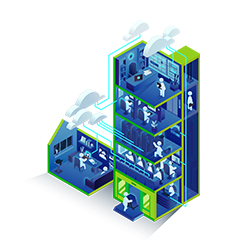Managing corporate devices across multiple locations and operating systems can be a logistical headache. IT teams need a way to streamline setup, enforce security policies, and keep systems updated—without spending hours on manual configurations.
That’s where Microsoft Intune and Windows Autopilot come in. Together, these cloud-based solutions automate endpoint management, ensuring devices are secured and configured the moment they reach employees—whether they’re working in-office, remotely, or across a hybrid environment.
What Are Microsoft Intune and Windows Autopilot?
Microsoft Intune is a cloud-based endpoint management solution that centralizes device management across Windows, iOS, Android, and macOS. It enables organizations to enforce security policies, control application access, and ensure compliance with corporate and regulatory requirements without requiring on-premises infrastructure.
Windows Autopilot, on the other hand, is a collection of technologies designed to simplify the out-of-the-box experience for deploying new devices. Autopilot enables pre-configured setup, security policies, and application deployments to be applied automatically. This ensures devices are ready for use immediately, whether employees are in-office or remote.
In short, Intune manages and secures devices throughout their lifecycle, while Autopilot streamlines the initial setup and deployment of new devices.
Why Do Businesses Need Modern Endpoint Management?
68% of organizations have experienced at least one (1) endpoint attack that successfully compromised data and/or their IT infrastructure. With remote and hybrid workforces becoming the norm, businesses need a modern way to provision, secure, and maintain devices at scale.
Key Challenges of Legacy Device Management
Slow provisioning: IT teams spend hours imaging and setting up new devices, reducing efficiency.
Weak security enforcement: Without automation, enforcing compliance and security policies becomes difficult and unreliable.
High IT costs: Deploying and managing devices manually increases resource consumption and overall IT expenses.
Poor scalability: Traditional methods fail to support large-scale deployments or adapt to remote and hybrid work environments.
With Intune & Autopilot combined, these challenges are addressed through automation, policy-based management, and seamless cloud integration.
How Intune & Autopilot Improve Security
Security is a major concern for IT leaders, especially with the increasing prevalence of cyber threats targeting endpoint devices. Intune and Autopilot work together to create a secure-by-design environment by implementing best-in-class security features.
Key Benefits of Intune & Autopilot
Zero-Touch Deployment: Deliver pre-secured devices, eliminating setup vulnerabilities.
Policy-Based Compliance & Security: Ensure encryption, MFA, and conditional access.
Automated Security Updates: Keep all devices protected with the latest security patches and OS updates.
Device Lifecycle Automation: Automate provisioning, policy enforcement, software updates, and device retirement.
Seamless Cloud Integration: Connect with Microsoft 365, Azure AD, and Microsoft Defender for unified endpoint security and management.
Scalability for Hybrid & Remote Workforces: Deploy, configure, and manage thousands of devices across distributed teams.
With Intune & Autopilot, IT teams can secure, automate, and scale device management with confidence—reducing risk, improving compliance, and enhancing the employee experience.
Why Choose Long View for Intune & Autopilot Deployment?
Deploying Intune and Autopilot successfully requires expertise in Microsoft solutions, security best practices, and IT operations. Long View’s Intune & Autopilot in 30 service is designed to deliver a structured and efficient deployment with minimal disruption to business operations.
The accelerated 30-day implementation framework consists of eight (8) key milestones:
- Initiate: Align project goals, define timelines, and establish stakeholder roles.
- Discover: Assess licensing, network architecture, and security requirements.
- Setup: Install and test Microsoft Intune and Windows Autopilot configurations.
- Configure: Apply key security policies, such as BitLocker and Windows Hello.
- Onboard: Initial onboarding of up to 100 devices and prepare for full rollout.
- Adopt: Develop change impact assessments and provide IT support materials.
- Transition: Establish ongoing support plans and documentation for IT teams.
- Monitor: Regularly review deployment status and refine strategies for continuous optimization.
What Sets Long View Apart?
Long View brings deep expertise in Microsoft technologies, with a proven track record of configuring and optimizing Microsoft Intune and Windows Autopilot for enterprise environments. Each deployment is tailored to meet security and compliance requirements, ensuring organizations adhere to industry regulations and best practices.
By seamlessly integrating with Microsoft Defender, Azure Virtual Desktop, and other enterprise security tools, Long View delivers a comprehensive approach to endpoint management. Beyond deployment, ongoing support and optimization help IT teams ensure long-term success with modern device management.
Ready to Modernize Endpoint Management?
Managing endpoints shouldn’t be a burden on IT teams. Intune & Autopilot in 30 provides businesses with a modern, efficient, and secure way to deploy and manage devices.
With expert guidance from Long View, organizations can transition to cloud-based endpoint management confidently and efficiently.
Want to learn more about our Intune and Autopilot in 30 service? Speak to an expert today.

Subscribe to our newsletter for the latest updates.